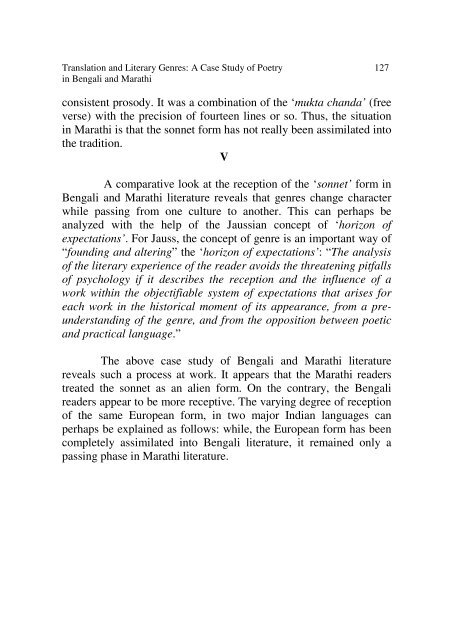Translation and Literary Genres: A Case Study of Poetry in Bengali ...
Translation and Literary Genres: A Case Study of Poetry in Bengali ...
Translation and Literary Genres: A Case Study of Poetry in Bengali ...
You also want an ePaper? Increase the reach of your titles
YUMPU automatically turns print PDFs into web optimized ePapers that Google loves.
<strong>Translation</strong> <strong>and</strong> <strong>Literary</strong> <strong>Genres</strong>: A <strong>Case</strong> <strong>Study</strong> <strong>of</strong> <strong>Poetry</strong> 127<br />
<strong>in</strong> <strong>Bengali</strong> <strong>and</strong> Marathi<br />
consistent prosody. It was a comb<strong>in</strong>ation <strong>of</strong> the ‘mukta ch<strong>and</strong>a’ (free<br />
verse) with the precision <strong>of</strong> fourteen l<strong>in</strong>es or so. Thus, the situation<br />
<strong>in</strong> Marathi is that the sonnet form has not really been assimilated <strong>in</strong>to<br />
the tradition.<br />
V<br />
A comparative look at the reception <strong>of</strong> the ‘sonnet’ form <strong>in</strong><br />
<strong>Bengali</strong> <strong>and</strong> Marathi literature reveals that genres change character<br />
while pass<strong>in</strong>g from one culture to another. This can perhaps be<br />
analyzed with the help <strong>of</strong> the Jaussian concept <strong>of</strong> ‘horizon <strong>of</strong><br />
expectations’. For Jauss, the concept <strong>of</strong> genre is an important way <strong>of</strong><br />
“found<strong>in</strong>g <strong>and</strong> alter<strong>in</strong>g” the ‘horizon <strong>of</strong> expectations’: “The analysis<br />
<strong>of</strong> the literary experience <strong>of</strong> the reader avoids the threaten<strong>in</strong>g pitfalls<br />
<strong>of</strong> psychology if it describes the reception <strong>and</strong> the <strong>in</strong>fluence <strong>of</strong> a<br />
work with<strong>in</strong> the objectifiable system <strong>of</strong> expectations that arises for<br />
each work <strong>in</strong> the historical moment <strong>of</strong> its appearance, from a preunderst<strong>and</strong><strong>in</strong>g<br />
<strong>of</strong> the genre, <strong>and</strong> from the opposition between poetic<br />
<strong>and</strong> practical language.”<br />
The above case study <strong>of</strong> <strong>Bengali</strong> <strong>and</strong> Marathi literature<br />
reveals such a process at work. It appears that the Marathi readers<br />
treated the sonnet as an alien form. On the contrary, the <strong>Bengali</strong><br />
readers appear to be more receptive. The vary<strong>in</strong>g degree <strong>of</strong> reception<br />
<strong>of</strong> the same European form, <strong>in</strong> two major Indian languages can<br />
perhaps be expla<strong>in</strong>ed as follows: while, the European form has been<br />
completely assimilated <strong>in</strong>to <strong>Bengali</strong> literature, it rema<strong>in</strong>ed only a<br />
pass<strong>in</strong>g phase <strong>in</strong> Marathi literature.

















